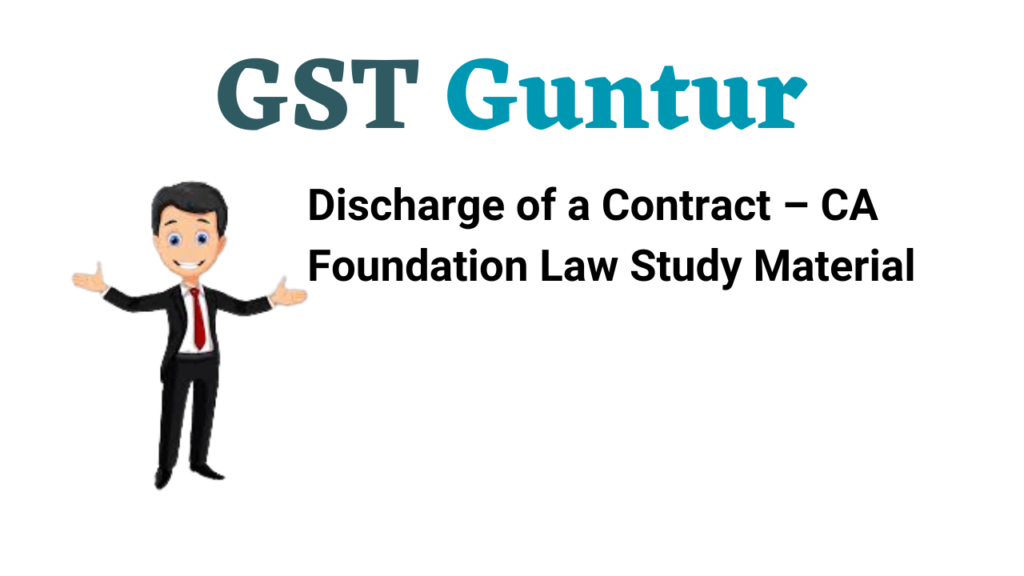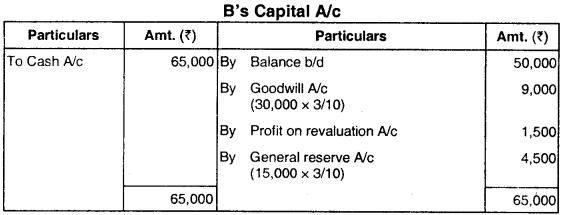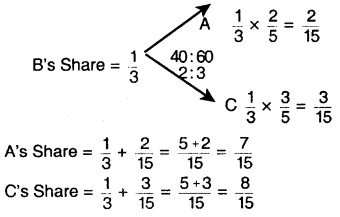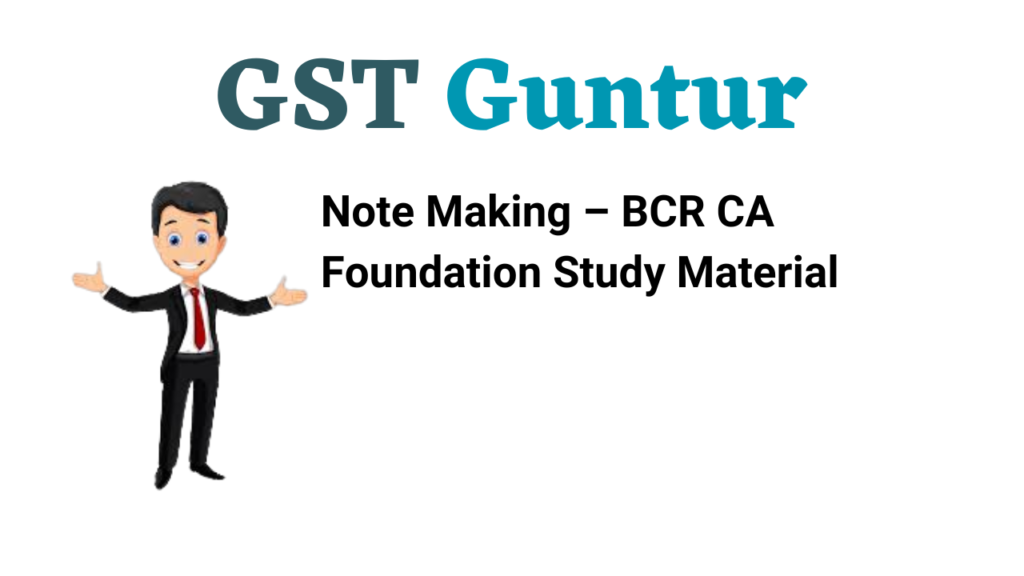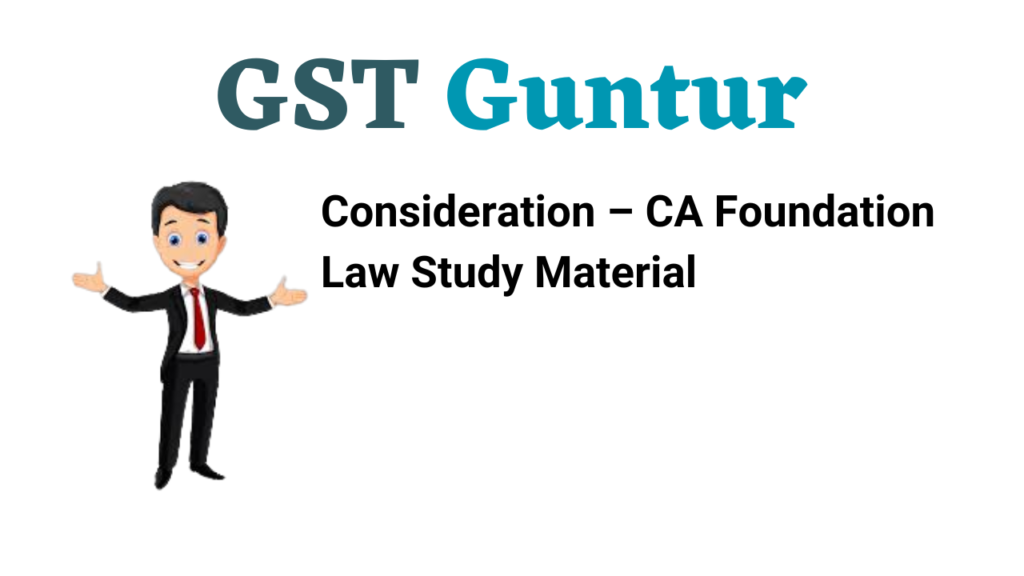Discharge of a Contract – CA Foundation Law Study Material
This Discharge of a Contract – CA Foundation Law Study Material is designed strictly as per the latest syllabus and exam pattern.
Discharge of a Contract – CA Foundation Business Law Study Material
Question 1.
What are the instances for discharge of contract by mutual agreement?
Answer:
Discharge by mutual agreement: By agreement of all parties, a contract may be canceled or its terms altered or a new agreement substituted for it. Whenever any of these things happen, the old contract is terminated. “If the parties to a contract agree to substitute a new contract for it, or to rescind or alter it, the original contract need not be performed.”Sec. 62.
![]()
Termination by mutual agreement may occur in any one of the following ways:
- NOVATION: Novation occurs when a new contract is substituted for an existing contract either between the same parties or between different parties. The consideration for the new contract is the discharge of the old contract.
- To effect a novation, there must be a valid enforceable new substituted contract.
- Consent of all parties is necessary for novation.
- Novation should take place before the breach or expiry of the old contract.
- ALTERATION: Alteration of a contract means a change in one or more of the terms of a contract. Alteration is valid if it is done with the consent of all the parties to the contract.
In alteration, there is a change in the terms of the contract but no change of the parties to it. In novation, there may be a change of parties. - REMISSION: Remission means acceptance of a lesser amount or lesser degree of performance than what was contracted for in full discharge of the contract.
According to sec. 63 a party may:
(a) Dispense with or remit performance wholly or in part; or
(b) Extend the time for performance; or
(c) Accept any other satisfaction instead of performance
For such a release or promise there is no need for consideration or new agreement.
Example: A owes B ? 5,000. A pays to B and B accepts in full satisfaction for the whole debt t 2,000. The old debt is discharged. A promise by the promisee to give concession to the promisor in one or the other form is binding even if without consideration. In Gopala v. Venkata, it was stated that after the remission has been communicated to the promisor and accepted by him, the promisee cannot claim the remitted (sacrificed) amount.
- RESCISSION: Rescission occurs when the parties to a contract agree to dissolve the contract. In the case of rescission, only the old contract is canceled and no new contract comes to exist in its place. The parties come out of the contract by mutual agreement.
- WAIVER: Waiver means the abandonment of a right. A party to a contract may relinquish (waive) his rights under the contract. Thereupon the other party is released from his obligations. For example, waiver of farmers’ bank loan by the Government. In such a case the banks give up their claim on the loan.
- MERGER: When an existing inferior right of a party, in respect of a subject matter merges into a newly acquired superior right of the same person, in respect of the same subject matter, then the previous contract conferring the inferior right stands discharged by way of merger.
Question 2.
What are the instances for discharge by operation by law?
Answer:
Discharge by operation of law: A contract terminates by operation of law in case of death insolvency, and merger.
(1) Death: In contracts involving personal skill or ability, death terminates the contract. In other cases, the rights and liabilities pass on to the legal representatives of the dead man.
(2) Insolvency: When a person is adjudged insolvent, he is discharged from all liabilities incurred prior to his adjudication. Upon insolvency, the rights and liabilities of the insolvent are, with certain exceptions, transferred to an officer of the court, known as the Official Assignee/Receiver.
(3) Merger: Means coinciding and meeting of inferior and superior rights in one and the same person. In such a case, the inferior right available to a party under the contract will automatically vanish.
(4) Lapse of time: Contracts may be terminated by lapse of time. In civil suits, the obligations and liabilities in contracts are barred by limitation. The provisions of the law are stated in the Limitation Act. For example, money suits should be hied within 3 years. Otherwise, they become time-barred.
(5) Unauthorised material alteration: If the terms of a contract are materially altered by a party to the contract without the consent of the other parties, the contract is discharged and cannot be enforced anymore.
![]()
Question 3.
What is meant by supervening impossibility? When is a contract said to be discharged by virtue of supervening impossibility?
Answer:
A contract, which at the time was entered into, was capable of being performed may subsequently become impossible to perform or unlawful. In such cases the contract becomes void. This is known as the doctrine of Supervening Impossibility. It is also known as the Doctrine of Frustration. Frustration occurs where it is established that due to subsequent change in circumstances, the contract has become impossible to perform or it has been deprived of its commercial purpose.
Supervening impossibility may occur in many ways, some of which are explained below:
(1) Destruction of the subject matter of contract
On the destruction of the subject matter, a contract is discharged and no party is liable to perform.
(2) Change of Law
The performance of a contract may become unlawful by a subsequent change of law. In such cases, the original contract becomes void.
(3) Non-concurrence of circumstances
When a contract is entered into on the basis of the continued existence of a certain state of things, the contract is discharged if the state of things changes.
- Illustration: A & B contract to marry each other. Before the time is fixed for the marriage, A goes mad. The contract becomes void.
(4) Death or incapacity for personal services
Where the personal qualification of a party is the basis of the contract the contract is discharged in cases of death or personal incapacity.
(5) Failure of the ultimate purpose of contracts :
Where the circumstances surrounding a contract change. Such that they result in a failure or the defeat of the ultimate purpose of contract, for which it had been performed, then the contract stands discharged.
(6) Outbreak of war
A contract entered into during war with an alien enemy is void ab initio. A contract entered into before the war commenced, between citizens of countries subsequently at war, generally becomes void.
![]()
Question 4.
State the grounds upon which a contract may be discharged under the provision of the Indian Contract Act, 1872.
Answer:
Grounds for discharge of contract:-
A contract can be discharged in any of the following ways:-
1. Discharge by Performance A contract may be discharged by Actual Performance or Attempted Performance. Actual Performance is said to
have taken place when each of the contracting parties has done what he had agreed to do under the contract. When the promisor offers to give his performance under the contract, but the promisee refuses to accept the same, then it amounts to discharge by attempted performance.
2. Discharge by Mutual Agreement:- The contracting parties may mutually agree to discharge the existing contract in any of the following ways:-
- Rescission
- Alteration
- Novation
- Remission
- Waiver
- Merger
3. Discharge by Operation of Law A contract shall stand discharged by operation of law in the event of any of the following
- Death or incapacity of the promisor in case of personal services (it) Insolvency
- Rights and Liabilities vest with the same person [Merger of Rights & Liabilities]
- Unauthorized Material Alteration.
- Loss of sole evidence of the contract
4. Discharge by Lapse of Time: – Where a contract is required to be performed within a specific period of time prescribed, the failure of the party to perform the same results in the discharge of contract on account of lapse of time.
5. Discharge by Supervening ImpossibilityA contract which was valid at the time of formation may subsequently become impossible or unlawful to perform and shall thereby stand discharged. A contract becomes void due to supervening impossibility in any of the following instances
- Destruction of subject matter
- Change of Law
- Non-concurrence of circumstances
- Death or incapacity for personal services
- Outbreak of war
- Failure of the ultimate purpose of the contract.
6. Discharge by BreachWhen a contracting party refuses or fails to give a performance or disables himself from giving a performance or makes the performance of the contract impossible by his conduct, then the contract is said to be discharged by the breach. A contract can be discharged by Actual Breach or by Anticipatory Breach. When the party commits default on the due date of performance, it amounts to an Actual breach, whereas when the default is committed before the due date of performance, it amounts to Anticipatory Breach.
![]()
Question 5.
What are the exceptional cases when a contract is not discharged by supervening impossibility?
Answer:
The doctrine of frustration or supervening impossibility does not apply in the following cases i.e. in these cases the contract is not discharged:-
1. Difficulty of performance
Sometimes the performance of a contract becomes difficult on account of some unanticipated events such as disruption of transport services etc. Such difficulty makes the performance hard but does not result in the discharge of the contract.
2. Commercial Impossibility
Commercial Hardships make the performance of the contract unprofitable or economically unviable. Thus commercial hardship on account of an increase in the price of inputs (raw materials) or overhead costs shall not result in the discharge of the contract.
3. Strikes, lock-outs, civil disturbances, and riots
These events do not terminate contracts unless there is a clause in the ‘ contract providing that in such cases the contract is not be performed or that the time of performance is to be extended.
4. Failure of one of the objects
When there are several purposes for which a contract is entered into, failure of one of the objects does not terminate the contract.
5. Impossibility due to failure of the third party
Where the performance of a contract by a party depends on the performance of a third party, the contract shall not be discharged by the failure or default of the third party.
6. Self-induced impossibility
A contract is not discharged on account of self-induced impossibility by either of the party.
![]()
Question 6.
What is meant by anticipatory breach of contract? State the rights of the promisee in case of such breach?
OR
“An anticipatory breach of contract is a breach of contract occurring before the time fixed for performance has arrived.” Discuss stating also the effect of anticipatory breach on contracts.
Answer:
Anticipatory breach of contract occurs :
- when a party before the time for performance is due announces that he is not going to perform the contract, or
- when a party by his own act disables himself from performing the contract.
When an anticipatory breach occurs, the aggrieved party can take the following steps:
(A)May treat the contract as discharged-
- He can treat the contract as discharged so that he is no longer bound by any obligations under the contract; &
- He can immediately adopt the legal remedies available to him for breach of contract, viz, file a suit for damages or specific performance or injunction.
(B)May not treat the contract as discharged-
Anticipatory breach, by itself, does not discharge the contract. The contract is discharged, when the aggrieved party chooses to treat it as discharged. The aggrieved party may decide not to rescind the contract but to treat the contract as alive and operative and wait for the time of performance. In such a case the consequences are as follows:
- The contract will be operative for the benefit of both parties. The contract will continue to exist and may even be performed by the other party.
- If the contract is not rescinded and subsequently an event happens which discharges the contract legally (e.g. a supervening impossibility) the aggrieved party loses his right to sue for damages.
![]()
Question 7.
What are the instances when the discharge of a contract by the operation of law takes place?
Answer:
A contract terminates by operation of law in case of death insolvency, and merger.
A. Death
In contracts involving personal skill or ability, death terminates the contract. In other cases, the rights and liabilities pass on to the legal representatives of the dead man.
B. Insolvency
When a person is adjudged insolvent, he is discharged from all liabilities incurred prior to his adjudication. Upon insolvency, the rights and liabilities of the insolvent are, with certain exceptions, transferred to an officer of the court, known as the Official Assignee/Receiver.
C. Merger of Rights & Liabilities
When the rights & liabilities under a contract vest with the same person then no further performance under the contract is required since it stands discharged.
D. Lapse of time
Contracts may be terminated by lapse of time. In civil suits, the obligations and liabilities in contracts are barred by limitation. The provisions of the law are stated in the Limitation Act.
E. Unauthorised material alteration
If the terms of a contract are materially altered by a party to the contract without the consent of the other parties, the contract is discharged and cannot be enforced anymore.
F.Loss of Evidence of contract
In case of loss of sole evidence as to the existence of a contract, the contract stands discharged due to operation of law.
![]()
Question 8.
What is meant by Suit for Specific Performance? What are the instances in which specific performance shall not be granted?
Answer:
There are cases where the damage or loss suffered cannot be measured in terms of money. The court, may, in such cases where the ordinary remedy by a claim for damages is not adequate compensation, direct the defaulting party to perform the contract specifically. (Under Sec. 12 of the Specific Relief Act, 1-963). Specific performance is an order of the Court directing the defendant to fulfill his obligations under the contract. Specific performance is a discretionary remedy and is only available where damages are not an adequate remedy.
Some of the cases where specific performance is ordered by the court are:
- Where the act itself is such that monetary relief for its non-performance is not adequate.
- Where no standard is available to ascertain the value of the actual damage caused by non-performance.
- Where it is not probable that the compensation money will be available. Examples: The specific performance is granted in contracts connected with land, buildings, rare articles, and unique goods having special value, etc. because the injured party will not be able to get an exact substitute in the market.
Specific performance is not allowed in the following cases:
- Where monetary compensation is an adequate relief.
- Where the contract is of personal nature, e.g. a contract to marry or a contract to paint a picture, or
- Where it is not possible for the court to supervise the performance of the contract e.g. a building contract.
- Where one of the parties to the contract is not competent to contract like a minor.
Question 9.
What Is meant by Suit for Quantum Meruit? What are the instances in which quantum meruit is granted?
Answer:
Quantum Meruit means ‘as much as merits’ or ‘as much as deserves or earns’. In a legal sense, it means ‘payment in proportion to the work done. In other words, quantum meruit means that a person can recover compensation in proportion to the work done or service rendered by him. It is a quasi-contractual remedy.
The claim on quantum meruit arises in the following cases:-
1. Where there is a breach of the contract
Where a party performs a part of the contract, but the other party breaks it in between, then the injured party can claim compensation for the work done or the service rendered.
2. When an agreement is discovered to be void
Where some work has been done and accepted under a contract that is subsequently discovered to be void, then the person who has performed the part of the contract is entitled to recover the amount for the work done. (Sec. 65)
3. When something has been done non-gratuitously
When something has been done non-gratuitously: Tue., has been done with the intention of getting payment. (Sec. 70)
4. Where work has been done by the person guilty of breaking the contract
In such a case defaulting party would be liable for consequences of breach, but for the work done by him he may be entitled to get payment in the following circumstances:
(a) Where the work to be done was divisible. A contract is divisible and a party performs a part of it and refuses to perform the remaining part, the defaulting party can claim reasonable compensation for the part performed, on the basis of quantum meruit. Thus two conditions should exist:
(a)If the contract is divisible, and
(b)If the party not at fault has enjoyed the benefit of part performance.
On the other hand, if the contract is not divisible, ie., it requires complete performance as a condition for payment, the party in default cannot claim payments for work done, on the basis of quantum meruit.
5. When the indivisible contract is performed substantially/fully
If a lump sum is to be paid for the completion of the entire work and the work has been completed in full, though badly, the person who has performed the contract can claim the lump sum; but the other party can also claim a deduction for bad work.
![]()
Question 10.
What are the types of damages that can be awarded as a remedy for breach under section 73 of the Indian Contract Act, 1872?
Answer:
According to Section 73 of the Indian Contract Act, 1872, damages are the monetary compensation allowed by a Court of Law to the aggrieved party for the loss/injury sustained by him on account of breach of contract by the other party. Damages are compensatory in nature and are granted in accordance with the following rules
1. Ordinary Damages are recoverable – The damages which are the natural and probable consequence of breach i.e. which naturally arise in the usual course of things from such breach can be recovered by the aggrieved party from the defaulting party.
2. Special Damages are recoverable only if the parties knew about them: These are those damages which are recoverable, in respect of losses that arise on account of the existence of some special or unusual circumstances provided the existence of the said circumstances was brought to the knowledge of the defaulting party at the time of formation of the contract. Thus these damages cannot be claimed as a matter of right by the plaintiff. They are not recoverable unless the special circumstances were brought to the knowledge of the defendant so that the possibility of the special loss was in the contemplation of the parties.
3. Remote or indirect damages are not recoverable able sine e these damages are not reasonably foreseeable and are not sustained by reason of the breach.
4. Nominal Damages for no loss sustained: Where the injured party has not in fact suffered any loss by reason of the breach of a contract, the damages recoverable by him are nominal. These damages are granted by the court to merely acknowledge that the plaintiff has proved his case & won.
5. Vindictive or exemplary damages are allowed only in specific instances Usually damages are awarded to compensate the aggrieved party and not with a view to punishing. However, in case of (a) Breach of a promise to marry & (b) Dishonour of a cheque by a banker wrongfully, the court may award exemplary damages.
6. The aggrieved party can also be granted damages for inconvenience, discomfort, mental agony etc. A further cost of the suit may also be allowed as damages by the Court.
![]()
Question 11.
Differentiate between liquidated damages & penalties.
Answer:
| Liquidated Damages | Penalty |
| Liquidated damages are the fair & genuine pre-estimate of the probable damages that are likely to arise as a consequence of the breach. | The penalty is not a genuine pre-estimate of damages. Instead, it is an amount that is highly disproportionate to the actual loss that is likely to arise in the event of a breach. |
| It is estimated and stipulated in the contract, with a view to ascertaining the damages to avoid the uncertainty of amount and to avoid expenses of proving damages in the court. | It is fixed and stipulated in the contract with a view to discourage a party from committing a breach of contract and secure due performance of the contract. |
| Liquidated damages are awarded by way of compensation | The penalty is imposed by way of punishment on the defaulting party. |
Question 12.
Mr. Ramaswamy of Chennai placed an order with Mr. Shah of Ahmedabad for the supply of urad dal on 10.11.2006 at a contracted price of ₹ 40 per kg. The order was for the supply of 10 tonnes within a months’ time viz., before 09.12.2006. On 04.12.2006 Mr. Shah wrote a letter to Mr. Ramaswamy stating that the price of urad dal was skyrocketing to t 50 Per. Kg. and he would not be able to supply as per the original contract. The price of urad dal rose to ₹ 53 on 09.12.06. Advise Mr. Ramaswamy citing the legal position.
Answer:
Hint: Increase in the price of urad dal does not amount to supervening impossibility (Sec. 56). Mr. Shah committed a breach of contract. If Ramaswamy waits till 09.12.2006 – Mr. Shah shall be liable to pay damages to Mr. Ramaswamy. The number of damages shall be 10 tons @ ₹ 13 per kg (i.e., the difference between the contract price and price as of 09.12.2006), ie., ₹ 1,30,000. However, if some supervening impossibility arises before 09.12.2006 (e.g., imposition of ban on trading in urad dal by the Government), the contract shall become void, and consequently, Mr. Shah shall not be liable to pay any damages. If Ramaswamy repudiates the contract on 04.12.2006 Mr. Shah shall be liable to pay damages to Mr. Ramaswamy. The number of damages shall be 10 tons (a ₹ 10 per kg (ie., the difference between the contract price and price as of 04.12.2 006), i.e., t 1,00,000.
![]()
Question 13.
A contracted with B to supply him (B) 500 tons of iron steel @ ₹ 5,000 per ton, to be delivered at a specified time. Thereafter, A contracts with C for the purchase of 500 tons of iron-steel @ ₹ 4,800 per ton, and at the same time told C that he did so far the purpose of performing his contract entered into with B. C failed to perform his contract in due course, consequently, A could not procure any iron-steel and B rescinded the contract. What would be the number of damages which A could claim from C in the circumstances? Explain with reference to the provisions of the Indian Contract Act, 1872.
Answer:
Hint: A can recover ₹ 1 lakh as special damages from C as it was within C’s knowledge that breach of contract by him(C) would result in non-performance of a contract between A and B resulting in loss of ₹ 1 lakh (ie., the difference between ₹ 5,000 per ton and ₹ 4,800 per ton for 500 tons) to A (Sec. 73).
Question 14.
M Ltd. contracts with Shanti Traders to make and deliver certain machinery to them by 30.6.2004 for ₹ 11.50 lakhs. Due to a labor strike, M Ltd. could not manufacture and deliver the machinery to Shanti Traders. Later, Shanti Traders procured the machinery from another manufacturer for ₹ 12.75 lakhs. Shanti Traders was also prevented from performing a contract which it had made with Zenith Traders at the time of their contract with M Ltd. and were compelled to pay compensation for breach of contract. Advise Shanti Traders the amount of compensation which it can claim from M Ltd. referring to the legal provisions of the Indian Contract Act.
Answer:
Hint: Labour strike does not amount to supervening impossibility (Sec. 56). Hence, non-delivery of machinery by M Ltd. results in a breach of contract by M Ltd. is liable to compensate the loss incurred by Shanti Traders, i.e. to pay ordinary damages of ₹ 1.25 lakhs (i.e., the difference between ₹ 12.75 lakhs and ₹ 11.50 lakhs) (Sec. 73). M Ltd. is not liable to pay any compensation for loss caused to Shanti Traders due to non-performance of the contract entered into with Zenith Traders; since special circumstances, viz. contract between Shanti Traders and Zenith Traders were not brought to the knowledge of M Ltd.
Question 15.
S, a singer, contracts with M, the manager of a theatre, to sing at the letter’s theatre for two evenings every week during the next two months. M engages to pay her ₹ 300 for each evening’s performance. On the seventh evening, S wilfully absents herself from the theatre. M, in consequence, wants to rescind the contract and claim compensation for the loss suffered by him through the non-fulfilment of the contract by S. Advise.
Answer:
Hint: M shall be entitled to rescind the contract and claim compensation from S because of breach of contract on the part of S. (Sec. 75 of the Indian Contract Act).
![]()
Question 16.
X borrows ₹ 1,000 from Y and agrees to repay the amount with interest at 12% at the end of six months. The contract further provides that in case of default in repayment, the interest will be payable at the rate of 70% from the date of default. What is the nature of this stipulation, and what is the right of Y.
Answer:
Hint: This stipulation is the nature of penalty. Y is entitled only to recover such compensation as the Court considers reasonable (but not exceeding 70% of interest).
Question 17.
A bank wrongfully dishonored a cheque of ₹ 1,000 belonging to Dhanna Seth (a Millionaire). He says that his credit has come down to the level of Moffat Lai (a person having only a few thousand rupees) as his cheque of Ek Hazar, i.e., one thousand has been dishonored wrongfully by the bank. Advise Dhanna Seth.
Answer:
Hint: Dhanna Seth can claim exemplary damages from the bank for the wrongful dishonor of the cheque. The smaller the amount of the cheque dishonoured the greater shall be the value of damages in this case.
![]()
Question 18.
A enters into a contract with B for supplying 800 tonnes of iron ore within 4 months. A fails to make the delivery in time owing to the difficulty in transport. But he admitted the availability of iron ore in the market at a higher price. Can A lake the plea of the impossibility of performance? Give reasons.
Answer:
Hint: No. The difficulty of performance should be distinguished from the impossibility of performance. Section 56 of the Indian Contract Act only declares those contracts void which becomes impossible of execution. Thus A is not discharged on grounds of the impossibility of performance.
Question 19.
‘X’ entered into a contract with ‘Y’ to supply him 1,000 water bottles @ ₹ 5.00 per water bottle, to be delivered at a specified time. Thereafter, ‘X’ contracts with ‘Z’ for the purchase of 1,000 water bottles @ ₹ 4.50 per water bottle, and at the same time told ‘Z’ that he did so for the purpose of performing his contract entered into with ‘Y’. ‘Z’ failed to perform his contract in due course and the market price of each water bottle on that day was ₹ 5.25 per water bottle. Consequently, ‘X’ could not procure any water bottle and ‘Y’ rescinded the contract. Calculate the number of damages which ‘X’ could claim from ‘Z’ in the circumstances? What would be your answer if ‘Z’ had not been informed about ‘ Y’s contract? Explain with reference to the provisions of the Indian Contract Act, 1872.
Answer:
BREACH OF CONTRACT- DAMAGES: Section 73 of the Indian Contract Act, 1872 lays down that when a contract has been broken, the party who suffers by such breach is entitled to receive from the party who has broken the contract compensation for any loss or damage caused to him thereby which naturally arose in the usual course of things from such breach or which the parties knew when they made the contract to be likely to result from the breach of it.
The leading case on this point is “Hadley v. Baxendale” in which it was decided by the Court that the special circumstances under which the contract was actually made were communicated by the plaintiff to the defendant, and thus known to both the parties to the contract, the damages resulting from the breach of such contract which they would reasonably contemplate, would be the amount of injury which would ordinarily follow from the breach of contract under these special circumstances so known and communicated.
The problem asked in this question is based on the provisions of Section 73 of the Indian Contract Act, 1872. In the instant case, ‘X’ had intimated to ‘Z’ that he was purchasing water bottles from him for the purpose of performing his contract with ‘Y’. Thus, ‘Z’ had the knowledge of the special circumstances. Therefore, ‘X’ is entitled to claim from ‘Z’ ₹ 500/- at the rate of 0.50 paise i.e. 1000 water bottles X 0.50 paise (difference between the procuring price of water bottles and contracted selling price to ‘Y’) being the amount of profit ‘X’ would have made by the performance of his contract with ‘Y’.
If ‘X’ had not informed ‘Z’ of ‘Y’s contract, then the number of damages would have been the difference between the contract price and the market price on the day of default. In other words, the number of damages would be ₹ 750/- (ie. 1000 water bottles X 0.75 paise).
![]()
Question 20.
Mr. JHUTH entered into an agreement with Mr. SUCH to purchase his (Mr. SUCII’s) motor car for ₹ 5,00,000/- within a period of three months. A security amount of ₹ 20,000/- was also paid by Mr. JHUTH to Mr. SUCH in terms of the agreement. After completion of three months of entering into the agreement, Mr. SUCH tried to contact Mr. JHUTH to purchase the car in terms of the agreement. Even after lapse of another three month period, Mr. JHUTH neither responded to Mr. SUCH, nor to his phone calls. After lapse of another period of six months. Mr. JHUTH contacted Mr. SUCH and denied purchasing the motor car. He also demanded back the security amount of ₹ 20,000/- from Mr. SUCH. Referring to the provisions of the Indian Contract Act, 1872, state whether Mr. SUCH is required to refund the security amount to Mr. JHUTH. Also examine the validity of the claim made by Mr. JHUTH, if the motor car would have been destroyed by an accident within the three-month’s agreement period.
Answer:
Hint: Breach of contract, the aggrieved party has a right to rescind the contract & claim restitution & damages if any. Further where any security deposit has been made under the contract, the same shall stand forfeited in case of breach of contract. Thus in the given case, Mr. JHUTH is responsible for breach of contract. Mr. SUCH, the aggrieved party can claim damages if any sustained by him. However, Mr. JHUTH is not entitled to a refund of ₹ 20,000/- since the same was given as a security deposit which shall now stand forfeited on account of his failure to fulfill the contract.
However, if the car had been destroyed by an accident within 3 months agreement period, then the contract would have been discharged by supervening impossibility due to destruction of subject matter and in such a case JHUTH would have been entitled to refund of security amount, (since the security amount can be forfeited only when a contract is not fulfilled on account of breach by a party.)
![]()
Question 21.
Mr. X and Mr. Y entered into a contract on 1st August 2018, by which Mr. X had to supply 50 tons of sugar to Mr. Y at a certain price strictly within a period of 10 days of the contract. Mr. Y also paid an amount of ₹ 50,000 towards advance as per the terms of the above contract. The mode of transportation available between their places is roadway only. A severe flood came on 2nd August 2013 and the only road connecting their places was damaged and could not be repaired within fifteen days. Mr. X offered to supply sugar on 20th August 2018 for which Mr. Y did not agree. On 1st September 2018, Mr. X claimed compensation of ₹ 10,000 from Mr. Y for refusing to accept the supply of sugar, which was not there within the purview of the contract. On the other hand, Mr. Y claimed a refund of ₹ 50,000, which he had paid in an advance in terms of the contract. Analyze the above situation in terms of the provisions of the Indian Contract Act, 1872, and decide on Y’s contention.
Answer:
When the performance of a contract is required within a specified period of time and the same becomes impossible by the occurrence of an unexpected event or a change of circumstances beyond the contemplation of parties, the contract becomes void & the contracting parties stand discharged from their obligation to perform the contract. Further when an agreement is discovered to be void or when a contract becomes void, any person who has received any advantage under such agreement or contract is bound to restore it or to make compensation for it to the person from whom he received it.
In the given case the contract between Mr. X and Mr. Y becomes void subsequently on 2nd Aug. 2018, when it becomes impossible to perform it within the stipulated time period due to floods. As a consequence both the parties are discharged. Thus, applying the above-stated provisions it can be concluded that the contract is discharged due to subsequent impossibility and Mr. X cannot claim damages from Mr. Y. However, Mr. Y is entitled to claim a refund of ₹ 50000/ – which was paid as an advance. Thus only restitution of benefits to Mr. Y shall be granted.
Question 22.
Mr. Rich aspired to get a self-portrait made by an artist. He went to the workshop of Mr. C, an artist, and asked whether he could sketch the former’s portrait on oil painting canvass. Mr. C agreed to the offer and asked for Rs. 50,000 as a full advance payment for the above creative work. Mr. C clarified that the painting shall be completed in 10 sittings and shall take 3 months. On reaching the workshop for the 6th sitting, Mr. Rich was informed that Mr. C became paralyzed and would not be able to paint for the near future. Mr. C had a son Mr. K who was still pursuing his studies and had not taken up his father’s profession yet? Discuss in light of the Indian Contract Act, 1872?
(1) Can Mr. Rich ask Mr. K to complete the artistic work in lieu of his father?
(2) Could Mr. Rich ask Mr. K for a refund of money paid in advance to his father?
Answer:
According to the provisions of section 56 of the Indian Contract Act, 1872 supervening impossibility results in the discharge of a contract. When the act required to be performed under the contract, becomes impossible subsequently without any fault of the contracting party, then the contract becomes void & the parties stand discharged from their obligations. Contracts of a personal nature, which require the exercise of personal skill or ability of a party, stand discharged on death or incapacity of the person. Similarly, non-concurrence of a particular state of things that was naturally contemplated for performance shall result in the discharge of the contract.
A contract discharged on the grounds of supervening impossibility becomes void & ceases to be enforceable. Further restitution shall be granted by the contracting party who has received any benefits & he shall be bound to restore the same back to the other party. Compensation shall not be granted in such a case. Thus applying the above-stated provisions to the given case it can be concluded that –
(1) Since the contract is of a personal nature, requiring the exercise of skill of Mr. C, it shall stand discharged on grounds of supervening impossibility on account of Mr. C’s incapacity. Further Mr. Rich cannot ask Mr. K to complete the artistic work in lieu of his father Mr. C since it is a contract of personal nature & hence cannot be performed by his legal representative.
(2) Mr. Rich can claim the refund of money paid in advance since the remedy of restitution is granted in the event contract becoming void & discharged on account of supervening impossibility.
![]()
Question 23.
On 20th September X agreed to sell to Y of 10 tons of a particular chemical to be manufactured in his factory @ Rs. 8,000 per ton to be delivered on 20th October. Calculate the number of damages that could be recovered by Y from X in each of the alternative cases:
Case (a): The chemical could not be manufactured because of a strike by the workers and X failed to supply the said chemical to Y on 20th October when the price of that chemical was Rs. 12,000 per ton.
Case (b) On 1st October, X informed Y that he was not going to supply the goods since the price of that chemical rose to Rs. 10,000 per ton on 1st October. The price of that chemical further rose to Rs. 12,000 per ton on 20th October.
I decided to rescind the contract on 1st October.
Case (c) On 1st October, X informed Y that he was not going to supply the goods since the price of that chemical rose to Rs. 10,000 per ton on 1st October. The price of that chemical further rose to Rs.12,000 per ton on 20th October.
I decided not to rescind the contract on 1st October and to wait til! 20th October. On 19th October, the entire chemical in the factory was destroyed by fire without the fault of either party.
Answer:
According to the provisions of Section 56 of The Indian Contract Act, 1872, a contact stands discharged on account of supervening impossibility if after the formation of the contract but before its performance, some event takes place which renders the performance of the contract impossible. In such a case both the parties stand discharged from their respective obligations and the contract becomes void subsequently. However in certain instances, such as those following, the contract is not discharged and is treated as subsisting and if the parties fail to perform the contract it shall amount to breach:
Case (a) Usually failure to perform on account of strikes by workers, does not amount to discharge by supervening impossibility unless a contract to the contrary is expressly made. Thus is in the given case when X fails to supply chemicals on account of a strike by workers, the contract is not discharged on account of supervening impossibility. The failure to supply the chemical amounts to breach and therefore X shall be bound to pay damages of Rs. 40,000 (12,000-8,000= 4,000 X 10) to Y
Case (b) Further, commercial hardships also do not result in the discharge of the contract on the grounds of supervening impossibility. Failure to perform the contract on the grounds that the contract has become less profitable or unprofitable due to changes in the prices, shall not amount to discharge by supervening impossibility. Instead, failure to perform in such a case amounts to a breach of contract and the defaulting party shall be bound to compensate the aggrieved party for the loss sustained by him.
Thus in the given case when X informs Y about his failure to perform on the grounds of an increase in the price of the chemical it amounts to a breach and X shall be bound to pay Rs. 20,000 (10,000-8,000=2,000 X 10) as damages to Y
Case (c) When a contracting party, before the due date of performance, refuses to perform the contract, it amounts to an anticipatory breach of contract. In such a case the contract is voidable at the option of the aggrieved party. The aggrieved party has the option to rescind the contract immediately without waiting for the due date of performance and sue for damages. Conversely, the aggrieved party can choose to continue with the contract and wait for the performance up to the due date and inform of his intention of doing so the defaulting party. In such a case the contract shall be treated as subsisting between them. Now if any event takes place during the waiting time period which renders the performance impossible then the contract stands discharged on the grounds of supervening impossibility.
Thus in the given case when Y decides to wait for the performance up to 20th October and the entire chemical in the factory is destroyed on 19th October, then the contract stands discharged on the grounds of supervening impossibility and Y now loses his right to claim any damages from X.
